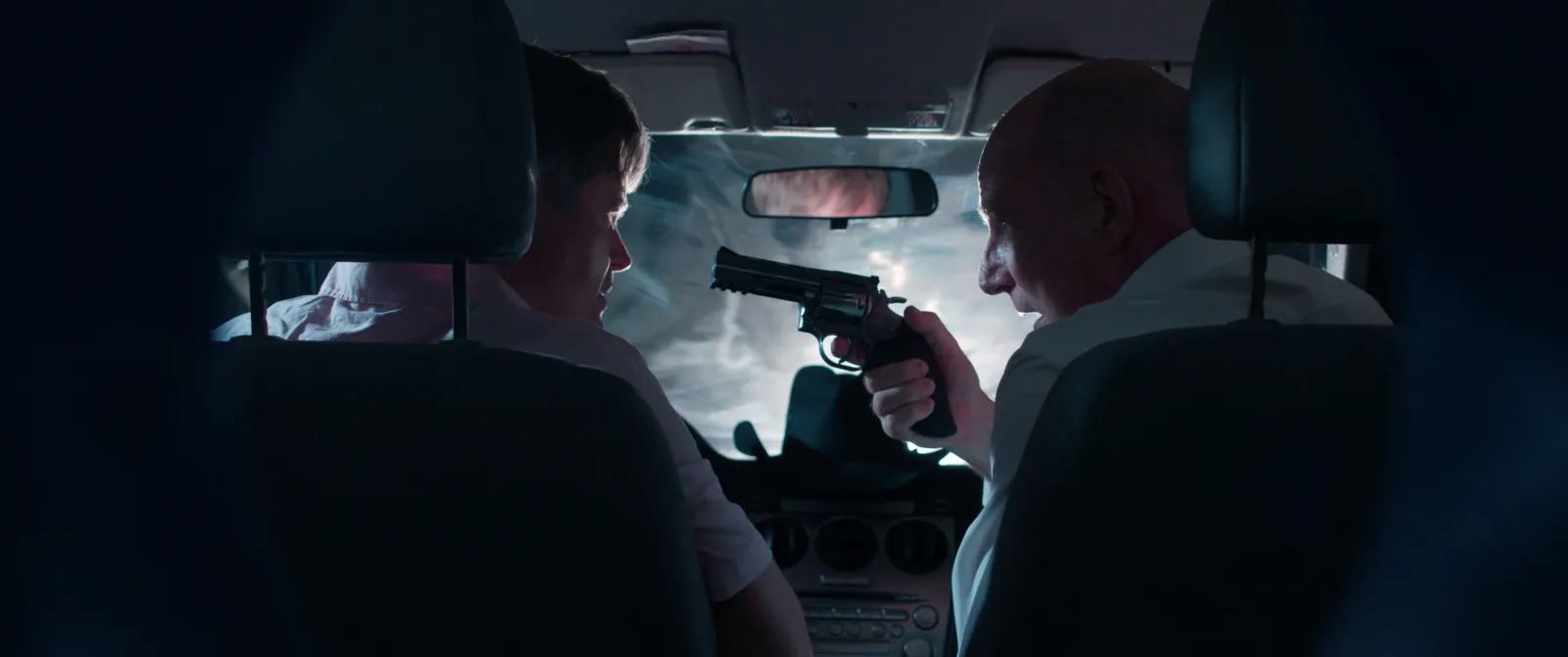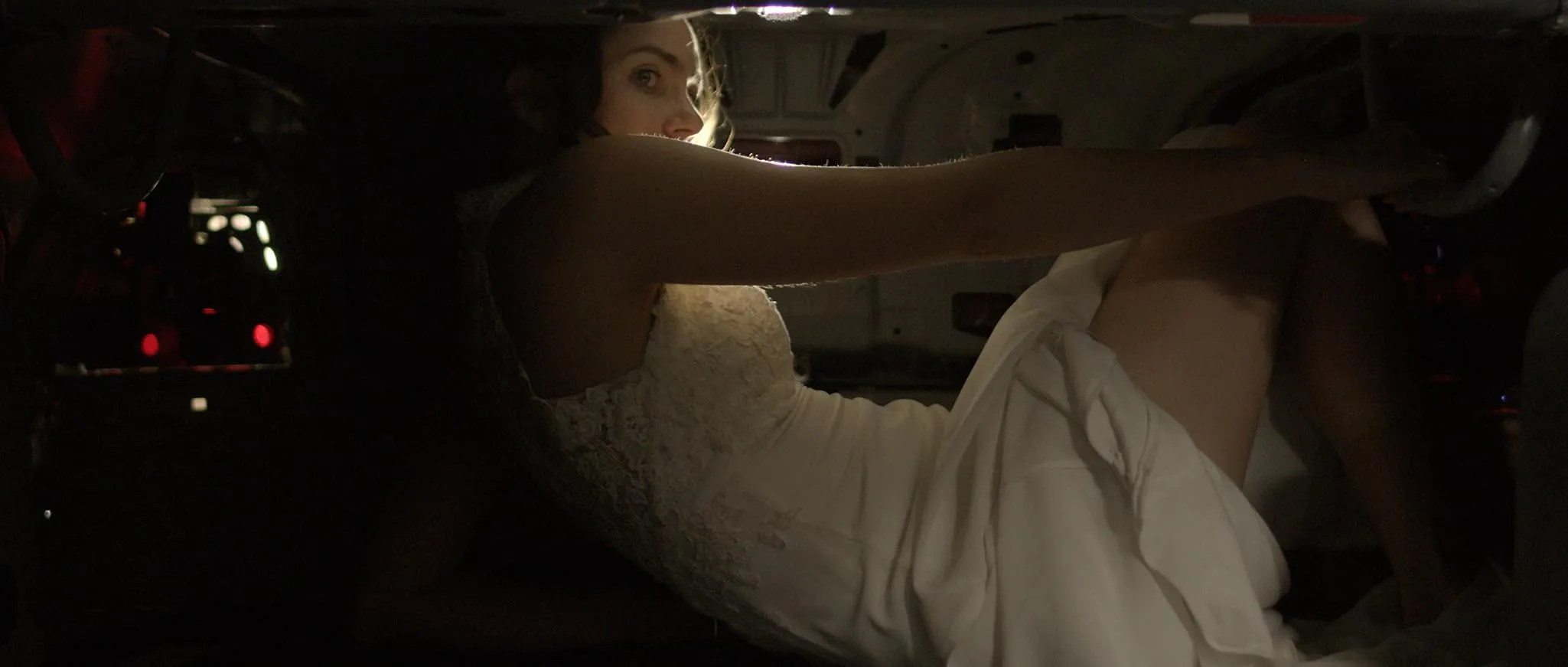Trapped in a cramped trunk with nowhere to go but along for the bumpy journey, Katharina Sporrer’s character Manda finds herself in quite the perilous position. In the low-budget Danish film The Girl in the Trunk, Manda awakes dressed in her ruined wedding gown, kidnapped and confined to the back of a speeding car with no idea who is at the wheel or what fate awaits her.
With only a mobile phone to keep her connected to the outside world and keen on escaping her mysterious tormentor, Manda faces challenges both physical and emotional as she fights to regain control of her destiny.
Helmed by writer-director Jonas Kvist Jensen on a shoestring budget, this thriller is a nail-biting premise brought to life by some clever visual storytelling within very constrained confines. No space for excess set pieces or elaborate action scenes here—only Manda, her phone, and the merciless movement of the vehicle carrying her to an unknown end.
It’s a testament to Sporrer’s strong central performance that keeps viewers fully invested in her character’s harrowing situation every step of the dangerous way. While not without its flaws, The Girl in the Trunk proves a taut piece of suspense that draws one tightly along for its claustrophobic ride.
Katharina Sporrer Offers a Tour de Force Performance While Trapped in a Trunk
Much of the success of The Girl in the Trunk relies on the shoulders of its star, Katharina Sporrer. As Manda, the unlucky bride trapped in a car trunk by her kidnapper, Sporrer has the unenviable task of carrying nearly the entire film from her confined space without relying on elaborate actions or surroundings.
Remarkably, she rises brilliantly to the challenge through a virtuoso display of emotional range that continually draws the viewer more deeply into Manda’s harrowing experience.
From the raw terror of initially waking to find herself imprisoned to simmering anger and growing desparation as her plight stretches on, Sporrer breathes complete life into her character’s fluctuating mental state. She understands intuitively how to craft nuanced facial expressions and body language that fully convey the gamut of feelings enveloping Manda without overplaying any single emotion. Viewers truly feel they’re getting to know and care about someone in peril thanks to Sporrer’s deeply empathetic and compelling work.
Perhaps most impressively, Sporrer generates palpable tension through quieter moments when Manda must strategize or have stressful phone conversations with her mysterious captor. She animates complex internal deliberations that continuously up the suspense. It’s a profoundly unsettling display that handily draws one into Manda’s shoes on her nerve-shredding odyssey to escape her confinement by any means necessary.
The Girl in the Trunk’s claustrophobic thriller conceit lives or dies on the strength of its central performance—and in Katharina Sporrer, it has found a real star capable of elevating the entire film through her incredible work trapped in that trunk.
Through Ingenuity and Imagination, The Director Crafts Claustrophobia Into Collar-Pulling Terror
Working within tight constraints—literally a trunk’s-eye view—The Girl in the Trunk director Jonas Kvist Jensen demonstrates keen ability to transform a limitation into a force multiplier. Through inventive application of camera and keen use of a protagonist’s confinement, he steadily escalates tension to an unsettling crescendo.
Nowhere is this more evident than a climactic encounter where a passerby attempts Manda’s rescue. By restricting perspective to a miniscule peephole in the trunk’s base, Jensen places us in the cramped quarters to share her limited sightline. Unaware of peril closing in, we witness in tight close-up the Good Samaritan’s grisly demise. The brutal uncertainty of what’s happening just beyond our nose practically pulls one out of their seat.
It’s a masterclass in suspense-building with sparse ingredients. Elsewhere, brief glimpses outside granted by a propped-open lid or mobile phone serve more to tease than alleviate claustrophobia. Combined with unnerving noises and sinister taunts piping through the speaker, the tension achieves near-unbearable heaviness.
This suffocating air of unease stems too from Manda’s own resourcefulness. Whether spying her surroundings or devising means of communication, her refusal to stop fighting back against circumstance despite perpetually dimming hopes keeps the struggle viscerally real.
The director leverages both character and setting to terrifically chilling effect, crafting 88 nail-biting minutes from a single elegant premise that leaves hearts pounding by the closing credits. In The Girl in the Trunk, constriction breeds not only despair but also some of the most effectively frightening scenes this genre has seen.
Capturing Compelling Villainy
While Katharina Sporrer turns in a terrific performance as the beleaguered but determined Manda, the same unfortunately can’t be said for her counterpart behind the steering wheel. The film seems to recognize this imbalance, minimizing direct interaction between our heroine and her tormentor. His muffled dialog over the phone and intercom lacks a sinister edge to truly put the fear in.
It’s a shame, because a more effectively chilling depiction could have ratcheted tensions even higher. Think of classic movie baddies whose dulcet, devious tones still freeze your blood decades on. The creeper from the original Texas Chainsaw Massacre comes to mind—you can almost see Leatherface dancing to his words. I picture someone with that unplaceable quality delivering the kidnapper’s cryptic cryptic musings and jabs, and Manda’s nerves would feel even more frayed.
Sporrer radiates a gritty resilience that keeps us rooting as the danger grows. But no one can withstand such psychological warfare alone for long without fraying. A darker, unhinged presence wrapping silky threats around her vulnerabilities may have pushed her resilience to its breaking point, keeping viewers equally unbalanced on the edge.
While the production deserves credit for ambition on a shoestring, a nuanced nemesis could have elevated this claustrophobic cat-and-mouse even higher. Sometimes the devil isn’t in detail but in tone—one well-placed voice acting choice may have made all the difference between an intriguing indie and a must-watch thriller that still haunts long after. Either way, kudos to all for giving it their all within limitations.
Removing Distractions, Refining Dread
While providing context can engage viewers, The Girl in the Trunk may have benefitted from less explanation and more emphasis on Manda’s harrowing situation. Details about her past seem better left unknown, freeing us to focus fully on her terrifying present. The occasional flashback could shed light, but pages of exposition pull attention from her urgent dilemma.
Stripping scenes away to keep the story tight and tense would intensify the creeping claustrophobia. Limiting distractions maintains an atmosphere where every action and reaction matters. Too much talk of what came before or could come next eases the pressure, though Manda’s plight calls for no relief from dread.
Even her kidnapper’s methods merit reconsideration. Watching poison critters tossed in stretched realism, as did one scheme borrowed from vintage spy flicks. While novelties can engage, the threats most chilling audiences arise from what seems possible, not purely sensational. Revised villianous whims stay grounded and thus feel truly frightening.
With restraint, the filmmakers could have amplified each instinct to root for Manda’s survival against a faceless danger. Pared back but no less compelling, her fight for freedom may have connected even more powerfully. Sometimes less truly can be more when suspense hangs in the balance. A leaner approach could have lent extra punch to an already tense trunkspace thriller.
Room for Improvement
While Sporrer shines as the brave yet beleaguered woman at the film’s center, weaknesses in other performances hindered The Girl in the Trunk from completely realizing its premise’s potential. Character voices rarely unsettled or even engaged listeners, cutting away from the on-screen conflict. Accents felt forced rather than natural.
English likely proved no easy task for some cast members. Speaking convincing dialogue in another language under pressure stands as a tall order. Yet casting native English speakers where possible might have elevated certain roles. On a limited budget, that option wasn’t feasible, but recognizing language challenges facing actors underscores room for enhancing future efforts.
Restrictions on resources also meant minimal sets and extras. But greater focus on dialogue delivery through additional takes or coaching may have strengthened what plays out between main characters. With a compelling foundation in place, surer line readings could have further immersed viewers in Manda’s desperation.
None of this criticizes the obvious passion put into producing The Girl in the Trunk outside industry support. It aimed high, telling an intriguing story, and mostly succeeded. But acknowledging modest flaws paves a constructive path, helping future thrillers maximize opportunities—and minimizing anything distracting audiences from an enthralling scenario’s full realization. Growth arises from both applause and areas earmarked for further development.
The Bottom Line
While The Girl in the Trunk may not be perfect in every area, it nonetheless delivers as a tense confined-space thriller guaranteed to leave audiences on the edge of their seats. The movie pulls viewers straight into the nightmare of Manda’s predicament and doesn’t let go until the very end. Those craving a thoroughly gripping and suspenseful ride will find it here in spades.
Admittedly, a few hiccups exist with some performances and lines that take some removing oneself. But in thrusting viewers smack into Manda’s terrifying ordeal, the film overwhelmingly works. It grips viewers just as much through unanswered questions as answers and builds an escalating sense of dread and anxiety throughout. When a movie manages this so effectively within limitations, it seems churlish to let minor flaws detract.
For fans of confined-space horrors and maximal tension-packed thrill rides, The Girl in the Trunk promises worthwhile scares, suspense, and thrills. Its strengths far outweigh its weaknesses for the experience it provides. So don’t miss this chance to be drawn into claustrophobic panic. Overlook small bumps and immerse in expertly crafted anxiousness sure to satisfy those with a taste for entrapping, edge-of-your-seat entertainment! Fans seeking such will find this film worthy of their time.
The Review
The Girl in the Trunk
While not perfect, The Girl in the Trunk delivers as an effective confined-space thriller through its gripping premise, tense atmosphere, and lead performance. For those seeking a suspenseful ride or claustrophobic chills, it provides worthwhile entertainment despite some minor acting hiccups.
PROS
- Gripping premise and realization of a confined-space scenario
- Tension-filled atmosphere maintained throughout
- Strong lead performance by Sporrer keeps viewers invested.
CONS
- Some uneven supporting performances
- Plot focuses more on backstory than escapism at times.
- Minor issues with dialogue delivery






















































Discussion about this post